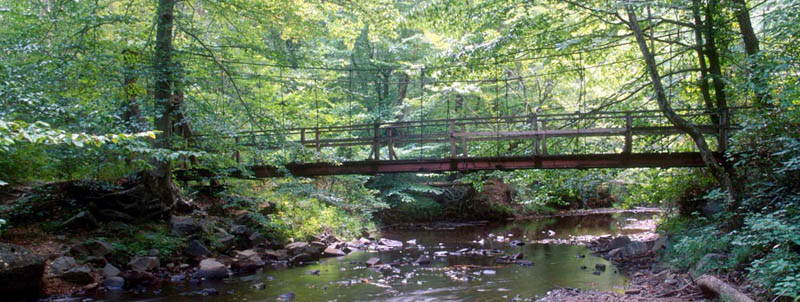
The beautiful serenity of Prince William Forest Park welcomed radio-orienteers in April, 2022.

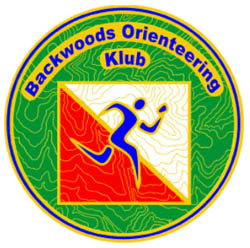 It's a perennial question: Where to have USA's annual national championships of Amateur Radio Direction Finding (ARDF)?
It's a perennial question: Where to have USA's annual national championships of Amateur Radio Direction Finding (ARDF)?
It's best when the championship venues are new to all competitors, so none have the advantage of familiarity. So the Sanctioning Subcommittee of the ARRL ARDF Committee is always on the lookout for fresh locations. A large wooded site is ideal, giving room for the four events in four different parts of it.
The Pacific Northwest has an abundance of outstanding possibilities. Other areas of the country such as the woods of the northeast, the Appalachian Mountains and the moss-covered trees of the south are quite good. Even mountainous parts of desert states like Arizona and New Mexico have suitable places for advanced radio-orienteering. The entire location doesn't have to be forested. Sometimes portions of championship orienteering courses include farm land or open grass.
Good up-to-date maps are a must. Most foxhunting champions are also skilled orienteers, expecting detailed topographical maps with contour lines at elevation intervals and accurate depiction of vegetation. Older maps need to be field-checked and updated before the event.
Almost every state has at least one site where a successful championship ARDF event could be held. But often there are no active ARDF groups or orienteering organizations near these sites. In 2007, radio-orienteers from various parts of California got together to put on the championships in the forests near South Lake Tahoe in the Sierra Mountains. Everyone slept in the cabins and ate in the dining room of Camp Concord, in the middle of well-mapped woods. Marvin Johnston KE6HTS of Santa Barbara was the Meet Director and Bob Cooley KF6VSE from the Bay area was the course designer and setter.
The Tahoe championships were so successful that in 2015 a group of ARDF enthusiasts from southern California put on an event in eastern Colorado, over 1100 miles from home. KE6HTS was the Meet Director again for these championships, which took place at the Peaceful Valley Scout Ranch near the tiny town of Elbert. Key to the success that year was Brian Coleman, now-KB0MAP, who had created excellent maps of the reservation. Some local help was provided by the Rocky Mountain Orienteering Club, but mostly it was the Los Angeles area hams who made it happen.
Helpers from afar made it possible to hold the 2018 USA Championships at Little Truckee Summit using an excellent new map by Bay Area Orienteering Club (BAOC) made just six years before. BAOC's Mapping Director KF6VSE was the course designer and the Meet Director was Jay Hennigan WB6RDV of Gates, Oregon.
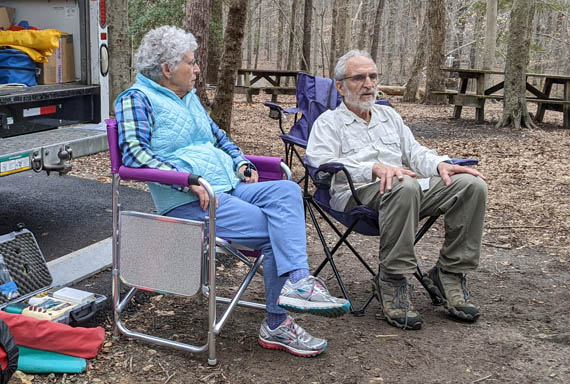
For the 2022 USA Championships, members of Backwoods Orienteering Klub of North Carolina drove 240 miles to Triangle, Virginia to set up in Prince William Forest Park. It borders the Quantico Marine Corps Reservation, 19 miles northeast of Fredricksburg and 29 miles southwest of Washington, DC. This park features almost 17,000 acres of mature hardwood forest including springs, ferns, creeks, and ponds. It is habitat for white-tailed deer, wild turkey, beaver and large concentrations of woodland birds, including thrush and warblers.
Organizing Co-Chairs for the 2022 USA Championships were Joseph Huberman K5JGH (Meet Director) and Ruth Bromer WB4QZG (Registrar). They have competed at many USA Championships and also have been on ARDF Team USA to the World Championships. Course Designer and leader of the setting team was Charles Scharlau NZØI.
Despite continuing travel difficulties due to COVID, 26 competitors plus the organizers arrived in Triangle. Some, like Bob Frey WA6EZV and Scott Moore KF6IKO, have been regular attendees at national championships since the first one in 2001. Others, like Tony Levand AA9CC, had experienced foxhunting in vehicles but were trying championship on-foot ARDF for the first time. Traveling from Australia was Jack Bramham VK3WWW and from Ontario, Canada was Robert Haddow VE3RXH.
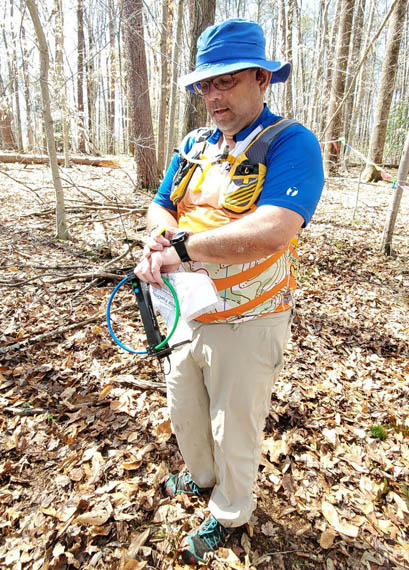
After finding all of the required transmitters from the first loop in any order, they run through the spectator corridor to the area with fast keyed foxes. After finding all required transmitters from this loop in any order, they run to the finish line. Twenty-five competitors set out in a light drizzle and the best performance was turned in by Norbert Linke of Maryland in M21 category. He punched in at all of the foxes and finished in 25:23.
Friday's contest was foxoring, another relatively new event that closely resembles classic orienteering because there are circles on the provided map near the continuously-transmitting QRPp 80-meter transmitters. Competitors use their orienteering skills to get to the circle locations, then perform direction-finding to home in on the foxes that can only be heard there.
Weather was much better this day, but unfortunately one transmitter failed to work. This necessitated some adjustment of the scores. Another difference from previous foxoring competitions was the use of three frequencies instead of one, in accordance with new International Amateur Radio Union (IARU) procedures. This is intended to solve the problem of very sensitive receivers hearing more than one fox transmitter on the same frequency between controls. In M21 category, where all nine working foxes had to be found, Gheorghe Fala did it in 1:04:08. In M70 category, with six required foxes, Joseph Huberman K5JGH finished in 47:49.
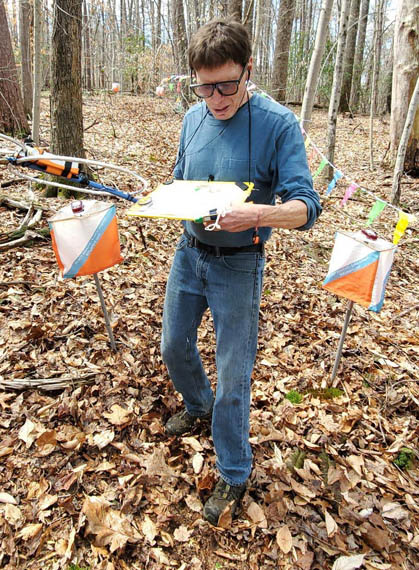
This was a difficult course with many possible route choices. The finish was in the south-central part of the map and the start was near the southeast corner. There were transmitters near the other three corners and in the west central area. Only six competitors out of 26 finished in less than two hours. Best times were by Vadim Afonkin KB1RLI (all four required M50 foxes in 1:21:38), Eduard Nasybulin (all five required M21 foxes in 1:22:23) and Alla Mezhevaya (all four required W45 foxes in 1:29:04).
Sunday, the final day, featured another classic event, this time on 80 meters. The course lengths for each category were about the same as for two meters, but course times were much faster. All competitors except five finished in less than two hours. Norbert Linke again showed his 80-meter RDF and orienteering skills by finding all five transmitters in an amazing 54:46.
It is typical for 80-meter course times to be faster on average than for two-meter equivalent courses. Eighty-meter signals do not reflect from terrain features to cause incorrect and confusing bearings like two-meter signals often do. The nulls on 80-meter ARDF sets provide sharper bearings than the pattern peaks of two-meter yagis. In addition, 80-meter sets are smaller, lighter and less awkward to carry than two-meter sets.
First, second and third place winners in each age/gender category and in each of the four events received medals. They were awarded at a pizza party on Saturday evening and right after the final event on Sunday.
Here are links to the official results.
Sprint competition, Thursday, April 7
FoxOring competition, Friday, April 8
Two-meter classic competition, Saturday, April 9
Eighty-meter classic competition, Sunday, April 10
Portions of this report have been excerpted from my Homing In column in the August 2022 issue of CQ Amateur Radio magazine.
Joe Moell KØOV
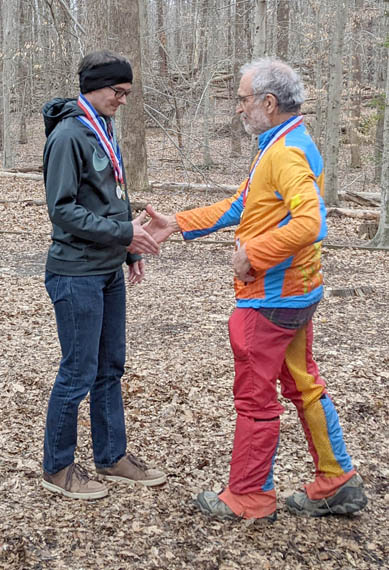
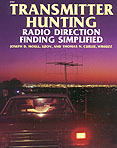 Go to Championships Foxhunting News -- Recent and upcoming ARDF championships events
Go to Championships Foxhunting News -- Recent and upcoming ARDF championships events
Go to International-Style Foxhunting Comes To The Americas -- How we're getting the ball rolling
Go to Equipment Ideas for Radio-Orienteering -- Simple and inexpensive receiving and transmitting solutions
Go to Radio-Orienteering News for Southern California -- Results and stories of recent radio-orienteering events in southern California, plus announcements of upcoming ones.
Go to Foxhunting for Scouts -- Let's get the kids involved
 Back to the Homing In home page
Back to the Homing In home page
This page updated 24 April 2023